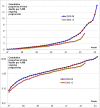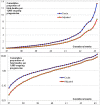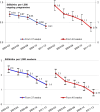Reduction in stillbirths at term after new birth induction paradigm: results of a national intervention
- PMID: 25125480
- PMCID: PMC4139643
- DOI: 10.1136/bmjopen-2014-005785
Reduction in stillbirths at term after new birth induction paradigm: results of a national intervention
Abstract
Objective: The risk of fetal death increases steeply after 42 gestational weeks. Since 2009, Denmark has had a more proactive policy including prevention of prolonged pregnancy, and early intervention in women with diabetes, preeclampsia, high body mass index and of a higher age group. The aim of this study was to describe the development in fetal deaths with this more proactive birth induction practice, and to identify and quantify contributing factors for this development.
Design: National cohort study.
Setting: Denmark.
Participants: Delivering women in Denmark, 1 January 2000 to 31 December 2012.
Outcome measures: Stillbirths per 1000 women at risk (prospective risk of stillbirth) and per 1000 newborn from 37 and 40 gestational weeks, respectively, through the study period.
Results: During the study period, 829,165 children were live born and 3770 (0.45%) stillborn. Induction of labour increased from 12.4% in year 2000 to 25.1% in 2012 (p<0.001), and the percentage of children born at or after 42 weeks decreased from 8.0% to 1.5% (p<0.001). Through the same period, the prospective risk of stillbirth after 37 weeks fell from 0.70 to 0.41/1000 ongoing pregnancies (p<0.001), and from 2.4 to 1.4/1000 newborn (p<0.001). The regression analysis confirmed the inverse association between year of birth and risk of stillbirth. The lowest risk was observed in the years 2011-2012 as compared with years 2000-2002 with a fully adjusted HR of 0.69 (95% CI 0.57 to 0.83). The general earlier induction, the focused earlier induction of women with body mass index >30, twins, and of women above 40 years and a halving of smoking pregnant women were all independent contributing factors for the decrease.
Conclusions: A gradually more proactive and differential earlier labour induction practice is likely to have mainly been responsible for the substantial reduction in stillbirths in Denmark.
Keywords: EPIDEMIOLOGY; OBSTETRICS.
Published by the BMJ Publishing Group Limited. For permission to use (where not already granted under a licence) please go to http://group.bmj.com/group/rights-licensing/permissions.
Figures




References
-
- Cousens S, Blencowe H, Stanton C, et al. National, regional, and worldwide estimates of stillbirth rates in 2009 with trends since 1995: a systematic analysis. Lancet 2011;377:1319–30 - PubMed
-
- Flenady V, Koopmans L, Middleton P, et al. Major risk factors for stillbirth in high-income countries: a systematic review and meta-analysis. Lancet 2011;377:1331–40 - PubMed
-
- Flenady V, Middleton P, Smith GC, et al. Stillbirths: the way forward in high-income countries. Lancet 2011;377:1703–17 - PubMed
Publication types
MeSH terms
LinkOut - more resources
Full Text Sources
Other Literature Sources
Medical
